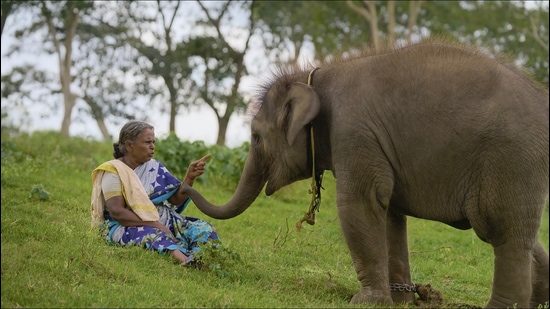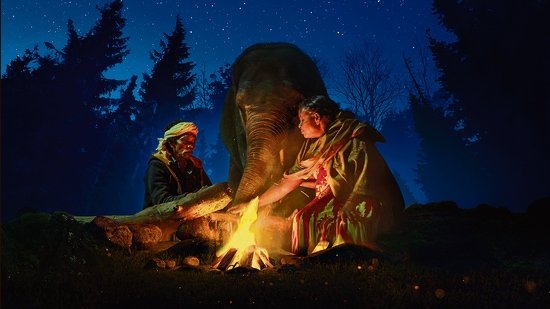Up to the tusk: A Wknd interview with the maker of The Elephant Whisperers
Kartiki Gonsalves's Oscar-nominated documentary follows a tribal couple in Tamil Nadu who adopted two orphaned elephant calves. It’ll be orcas next, she says.
About five years ago, Kartiki Gonsalves was driving to her home in Ooty, Tamil Nadu, when she came upon Bomman Kattunayakan, a caregiver at the elephant camp within the Mudumalai Tiger Reserve. He was walking along the road with Raghu, an elephant calf he’d adopted.

“They were on their way to the river for Raghu’s bath and I started a conversation with Bomman. Observing them, I was struck by the bond they shared,” says Gonsalves, 36. “At three months old, Raghu looked small and vulnerable. Bomman was his mother, father, friend, everything.”
That chance meeting would alter the trajectory of Gonsalves’s career. Until then a photographer, it inspired her first film, The Elephant Whisperers (2022; 42 minutes), which tells the story of Bomman, his wife Bellie Kattunayakan and their two baby elephants, Raghu and Ammu.
As Gonsalves tours the US with her film (she is currently in Los Angeles), she has seen how the unusual story strikes a chord. It has been shortlisted for an Oscar in the documentary short category.
Watch: Kartiki Gonsalves, on filming The Elephant Whisperers
The Elephant Whisperers opens with a healthy Raghu splashing in a river. When he was first found by forest rangers, he was covered in infected wounds. He had been wandering alone after his mother died of electrocution, and had been attacked by wild dogs. Bomman, a member of the Kattunayakan forest-dwelling tribe, was assigned to care for him. He decided to make the calf’s survival his sole focus, and took the fuzzy little elephant to his home within the reserve.
“I wasn’t trained to care for elephants,” Bellie says, in the film. But when she first met the three-month-old calf, he tugged at her clothes “and I felt his love”. The rest of the film follows this little family as they care for Raghu, then take on Ammu, another separated calf.
How did Gonsalves do it, -- a first-time director, working in the heart of a forest, following two unpredictable baby elephants that weighed about 150 kg each.
The difficulties were part of the reason it took five years to make the film, Gonsalves says. “I spent the first year-and-a-half just building a bond with Bomman, Bellie and Raghu.” She also worked with a minimal crew of three. When she eventually began filming, she wanted them to be so used to it all, they would forget the camera was there.
The result is rare, endearing snapshots, such as one in which Bellie tells Ammu to lie down next to her, “but not on me again, or you’ll get a spanking”. In another universal moment, during bath time, Bomman asks Raghu, “Who’s the best elephant?” Elsewhere, the couple is enjoying some quiet time outside their home at sundown and decide to get bedtime routine going. “He looks sleepy,” Bellie says.
Gonsalves let the shooting stretch out, gathering more than 450 hours of footage, “because you can’t predict these moments.”

Through it all, another character emerges as a key player: the forest. The viewer sees it as the Kattunayakan do — a shared, sacred space that belongs equally to the humans, elephants, eagles, hares, monkeys, tigers and leopards. “We walk in the forest barefoot, to show respect to it… we don’t take anything more than necessary,” Bellie says.
Capturing this meant that Gonsalves and her crew were out in the wilds too. “We’ve had a leopard cross our path as we were returning after a day of filming. Another time, we were shooting when we heard a leopard attack a wild boar. It happened so close to us that we could hear everything crystal clear.”
The film captures Bellie and Bomman’s wedding too; they married during the course of filming. (At the ceremony, Raghu, who loves flowers, tried to eat his own garland.) “To be able to witness that day was special,” Gonsalves says.
***
Her love of visual storytelling comes from her family, says Gonsalves. “My father is a photographer, and my mother an animal-lover. My grandmother was an amateur naturalist who guided school children through local nature reserves. I was introduced to nature before I could even walk. Instead of going to malls or the movies, my family would go to forests and beaches, mountains and zoos. I was 18 months old when the family took me camping for the first time.”
Growing up within the Nilgiri Biosphere Reserve, in Ooty, meant that wildlife was always close by. “There are camera traps just outside our gate that have captured leopards and tigers,” Gonsalves says. She knew she wanted to be a photographer, began a career in graphic design and advertising along the way, then gave those up to follow her original passion.

Now, of 98 documentary shorts that qualified for the Academy Awards, her film has made it to the shortlist of 15. The five final nominees will be announced on January 24.
As she waits to hear how The Elephant Whisperers has fared, Gonsalves has zeroed in on the story she wants to tell next. “I’m going to the other side of the world, to look at orcas in the Pacific Northwest and their relationships with the people of First Nations. Like elephants, orcas are very intelligent and beautiful beings. The indigenous people of the land share a very deep, almost reverential connection with them,” she says.
Meanwhile, before this first film premiered on Netflix in December, Gonsalves headed back to Mudumalai, to screen it for Bomman and Bellie. “They were in tears the whole time. They are excited to share their lives with the world, give their community and people a voice,” she says.
It was a particularly emotional viewing because Raghu no longer lives with them. He’s grown up and moved out; Soon, Ammu will too. As with all parenting, that is the goal. Knowing that doesn’t make it any easier, though.
Catch your daily dose of Fashion, Health, Festivals, Travel, Relationship, Recipe and all the other Latest Lifestyle News on Hindustan Times Website and APPs.
Continue reading with HT Premium Subscription




